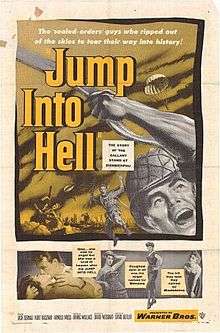Jump into Hell
| Jump into Hell | |
|---|---|
 Original film poster | |
| Directed by | David Butler |
| Produced by | David Weisbart |
| Written by | Irving Wallace |
| Starring |
Jack Sernas Kurt Kasznar Arnold Moss |
| Music by | David Buttolph |
| Cinematography | J. Peverell Marley |
| Edited by | Irene Morra |
Production company |
Warner Brothers Pictures, Inc. |
| Distributed by | Warner Brothers Pictures, Inc. |
Release dates |
|
Running time | 93 minutes |
| Country | United States |
| Language | English |
Jump into Hell is a 1955 war film directed by David Butler. The film stars Jacques Sernas (billed as "Jack Sernas") and Kurt Kasznar. The first contemporary Hollywood war film of the war in Indochina, the story is a fictionalized account of the Battle of Dien Bien Phu.[1]
Plot
In 1954, Dien Bien Phu, a French-controlled fortress in Indochina, is under siege by Viet Minh rebels. Commanding officer De Castries (Arnold Moss) has been betrayed by a formerly loyal Chinese officer (Philip Ahn) and is desperate for new leadership for his men. He radios Hanoi for help.
At French headquarters in Paris, Captain Guy Bertrand (Jacques Sernas), a prisoner of war for three years during World War II, volunteers to join the fray. He wants to see action as well as rendezvous with a former love, Gisele (Patricia Blair), who is unhappily married to Bonet, a major at the fort. Also on their way are Captain Callaux (Kurt Kasznar), goaded into it by a nagging, social-climbing wife; Lieutenant Heldman (Peter van Eyck), a former Nazi fighter who is now a legionnaire; and the naive but eager Lieutenant Maupin (Norman Dupont).
The men parachute in and, with great difficulty, get to the fort. A monsoon rages and the fight drags on for weeks. Heldman heroically staves off enemy soldiers armed with explosives and kills them with a grenade before meeting his own fate. Bonet attempts to stop the Viet Minh attack by approaching enemy lines under a white flag, but is gunned down. Bertrand tries in vain to rescue him.
Low on ammunition, water and other supplies, Callaux, despondent after having learned in a letter that his wife has been unfaithful, volunteers to get water from a nearby river. He changes his will, leaving her nothing, and has it sent off via helicopter. He returns to the fort with the water, but dies just as he delivers it.
The situation is hopeless. The enemy is tunneling in and, now without ammo, the Frenchmen must resort to hand-to-hand combat. In his final act, de Castries orders Bertrand and Maupin to try to escape. De Castries takes a last look around, realizing that the end for him is near.
Cast
- Jacques Sernas as Captain Guy Bertrand (credited as Jack Sernas)
- Kurt Kasznar as Captain Jean Calluox
- Arnold Moss as General Christian De Castries
- Peter van Eyck as Lieutenant Heinrich Heldman
- Marcel Dalio as Sergeant Taite
- Norman Dupont as Lieutenant André Maupin
- Lawrence Dobkin as Major Maurice Bonet
- Patricia Blair as Gisele Bonet (credited as Pat Blake)
- Lisa Janti as Jacqueline (credited as Irene Montwill)
- Alberto Morin as Major Riviere
- Maurice Marsac as Captain Leroy
- Louis Mercier as Captain Darbley
- Leon Lontok as Lieutenant Pham
- Peter Bourne as Lieutenant Robert
- Roger Valmy as Major Lamoreaux
- Wong Artarne as Radio man
- Philip Ahn as Chinese lieutenant
- William Yip as Captain Han
- Victor Sen Yung as Lieutenant Thatch
- Ben Wright as Captain Pluen
- Harold Dyrenforth as Major Flandrin
- Gene D'Arcy as Captain Jardin
- Roger Pace as Captain Rogers
- Lomax Study as Captain Daniel
- My Anzel as Lieutenant Turel
- Trudie Wyler as Yvette
- Gregory Gaye as Lieutenant Colonel Cartier
- Joe Romantini as Officer
- Charles Bastin as Officer
- Eddie Fosteras Officer
Production
Principal photography on Jump into Hell began on September 23, 1954 and lasted until late October.[2] Battle scenes were shot at the Janes Ranch in Conejo, California. Additional battle scenes combined Warner-Pathe newsreel footage of the fall of Dien Bien Phu with live-action scenes.[3]
Reception
Reviewer Frank Miller in the Turner Classic Movies website saw Jump into Hell as typical of the period when films were examples of Cold War "jingoism". "The spoken prologue compares the Battle of Dienbienphu to fall of the Alamo and the British evacuation at Dunkirk. An early confrontation between French general Arnold Moss and captured Chinese officer Philip Ahn clearly identifies the enemy not as the Viet Minh, but international Communism. Little is said of the fact that the French defeat, with massive casualties before and after the surrender, helped inspire the nation to withdraw from its former colony. For all its jingoism, the film has its charms, particularly in the performances of an international cast."[3]Leonard Maltin considered Jump into Hell, as a, "Neatly paced actioner of paratroopers involved in Indochina war."[4]
See also
References
Notes
- ↑ Evans 2000, p. 110.
- ↑ "Original print information:'Jump into Hell' (1955)." Turner Classic Movies. Retrieved: December 20, 2015.
- 1 2 Miller, Frank. "Articles:'Jump into Hell' (1955)." Turner Classic Movies. Retrieved: December 20, 2015.
- ↑ Maltin, Leonard. "Leonard Matin Movie Review:'Jump into Hell' (1955)." Turner Classic Movies. Retrieved: December 20, 2015.
Bibliography
- Evans, Alun. Brassey's Guide to War Films. Dulles, Virginia: Potomac Books, 2000. ISBN 1-57488-263-5.
- Maltin, Leonard. Leonard Maltin's Movie Guide 2009. New York: New American Library, 2009 (originally published as TV Movies, then Leonard Maltin’s Movie & Video Guide), First edition 1969, published annually since 1988. ISBN 978-0-451-22468-2.
External links
- Hell's Angels at the TCM Movie Database
- Jump into Hell at the Internet Movie Database
- Hell's Angels at AllMovie